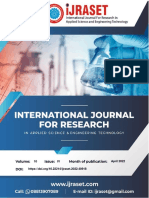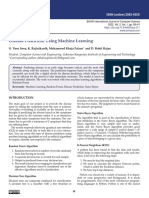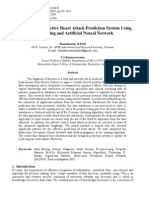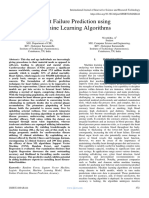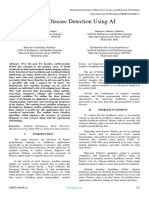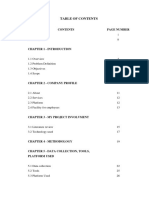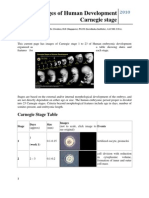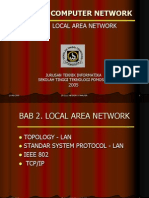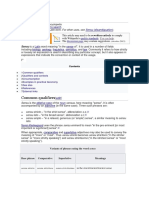Predict The Heart Attack Possibilities Using Machine Learning
Predict The Heart Attack Possibilities Using Machine Learning
Volume 9, Issue 4, April – 2024 International Journal of Innovative Science and Research Technology
ISSN No:-2456-2165 https://doi.org/10.38124/ijisrt/IJISRT24APR1878
Predict the Heart Attack Possibilities Using
Machine Learning
Pratik Bodake1; Akash Shevkar 2; Jaydeep Padwal3; Yogeshwari Hardas4
1,2,3,4
Student, Dept of Computer Engineering, Atma Malik Institute of Technology and Research, Maharashtra, India
4
Prof ., Head of Department of Computer Engineering, Atma Malik Institute of Technology and Research, Maharashtra, India
Abstract:- Heart disease remains one of the leading II. LITERATURE SURVEY
causes of mortality worldwide, making early detection
and prevention crucial. Machine learning techniques [1] Traditional Risk Factors and Beyond: Early studies
offer promising avenues for predicting heart attack often focused on traditional risk factors such as age, gender,
possibilities by analyzing patient data and identifying hypertension, and cholesterol levels. However, more recent
risk factors. This study explores the development of a research has expanded to include novel predictors such as
predictive model using machine learning algorithms to genetic markers, lifestyle factors, psychosocial variables,
assess the likelihood of a heart attack based on and emerging biomarkers like high-sensitivity C-reactive
individual patient characteristics and medical history. protein (hs-CRP) and homocysteine levels.
The dataset comprises a comprehensive range of [2] Datasets and Cohorts: Researchers have utilized
features including demographic information, lifestyle various datasets and cohorts for heart attack prediction,
factors, medical history, and results from diagnostic tests including longitudinal studies like the Framingham Heart
such as electrocardiograms (ECG), cholesterol levels, Study, the UK Biobank, and electronic health records (EHR)
and blood pressure readings. Preprocessing techniques databases from healthcare institutions. These datasets
such as data cleaning, normalization, and feature provide rich sources of information for training and
engineering are applied to prepare the dataset for validating machine learning models.
analysis. Looking ahead, the article identifies promising
avenues for future research, including the integration of [3] Feature Engineering and Selection: Feature
multimodal data sources, real-time risk assessment engineering plays a crucial role in extracting relevant
systems, and collaborative efforts to develop information from raw data. Studies have explored different
standardized benchmarks and evaluation protocols. By techniques for feature selection, dimensionality reduction,
synthesizing the collective knowledge gleaned from and handling missing values to enhance model performance
decades of research, this historical review aims to inform and interpretability.
and inspire ongoing endeavors in leveraging machine
learning for proactive cardiovascular health [4] According to Krittanawong, Chayakrit, et al.
management and prevention strategies. "Artificial intelligence in precision cardiovascular
medicine." Journal of the American College of Cardiology
Keywords:- Support Vector Machine ,Machine Learning 2017.
Algorithm, Computational Modeling.
[5] According to Motwani, Manish, et al. "Machine
I. INTRODUCTION learning for prediction of all-cause mortality in patients with
suspected coronary artery disease: a 5-year multicentre
Heart disease remains a significant global health prospective registry analysis." European heart journal 2017
concern, responsible for a substantial portion of mortality
and morbidity worldwide. Among the various [6] According to Choi, Eunho, et al. "Cardiovascular
cardiovascular conditions, heart attacks, or myocardial disease prediction using deep learning techniques: A
infarctions, pose a particularly grave threat due to their review." In 2016 IEEE International Conference on
sudden onset and potentially life-threatening consequences. Healthcare Informatics (ICHI), pp. 209-215. IEEE, 2016
Early identification of individuals at risk of experiencing a
heart attack is paramount for implementing preventive
measures and timely interventions to mitigate adverse
outcomes.
IJISRT24APR1878 www.ijisrt.com 1193
Volume 9, Issue 4, April – 2024 International Journal of Innovative Science and Research Technology
ISSN No:-2456-2165 https://doi.org/10.38124/ijisrt/IJISRT24APR1878
III. PROPOSED SYSTEM IV. CONCLUSION
The process typically includes steps such as data The proposed system represents a comprehensive
preprocessing, feature selection, model training, evaluation, approach to predicting heart attack possibilities using
and validation. machine learning, leveraging advanced computational
techniques and interdisciplinary collaboration to enhance
The resulting predictive models can assist healthcare cardiovascular risk assessment and preventive care. By
providers in identifying individuals at high risk of a heart harnessing the power of data-driven insights, the system
attack, enabling proactive interventions such as lifestyle aims to improve patient outcomes, reduce healthcare costs,
modifications, medication adjustments, or referral to and alleviate the burden of heart disease on individuals and
specialized care. healthcare systems worldwide.
Overall, predicting heart attack possibilities using REFERENCES
machine learning holds the potential to improve early
detection, optimize preventive strategies, and ultimately [1]. Fatima M, Pasha M: Survey of machine learning
reduce the incidence and severity of heart disease. algorithms for disease diagnostic. J. Intell. Learn. Syst.
Appl. 2017; 09: 1–16. Publisher Full Text
[2]. Singh RS, Saini BS, Sunkaria RK: Detection of
coronary artery disease by reduced features and
extreme learning machine. Med. Pharm. Rep. 2018;
91(2): 166–175. PubMed Abstract | Publisher Full Text
[3]. Yaghouby F, Ayatollahi A, Soleimani R: Classification
of cardiac abnormalities using reduced features of heart
rate variability signal. World Appl. Sci. J. 2009; 6(11):
1547–1554.
[4]. Asl BM, Setarehdan SK, Mohebbi M: Support vector
machine-based arrhythmia classification using reduced
features of heart rate variability signal. Artif. Intell.
Med. 2008; 44(1): 51–64. PubMed Abstract | Publisher
Full Text.
Fig 1 Block Diagram of the Proposed System
IJISRT24APR1878 www.ijisrt.com 1194
You might also like
- The Shane 10 Unit Apartment Building Plan - 83128DC - Architectural Designs - House PlansNo ratings yetThe Shane 10 Unit Apartment Building Plan - 83128DC - Architectural Designs - House Plans4 pages
- Prediction of Risk in Cardiovascular Disease Using Machine Learning AlgorithmsNo ratings yetPrediction of Risk in Cardiovascular Disease Using Machine Learning Algorithms6 pages
- Heart Disease Prediction Using Machine LearningNo ratings yetHeart Disease Prediction Using Machine Learning7 pages
- Heart Attack Predictions Using Machine LearningNo ratings yetHeart Attack Predictions Using Machine Learning8 pages
- Multi-Class_Stress_Detection_through_Heart_Rate_VaNo ratings yetMulti-Class_Stress_Detection_through_Heart_Rate_Va12 pages
- Predicting Coronary Heart Disease Using An Improved LightGBM Model Performance Analysis and ComparisonNo ratings yetPredicting Coronary Heart Disease Using An Improved LightGBM Model Performance Analysis and Comparison15 pages
- An AI-Based Medical Chatbot Model For Infectious Disease PredictionNo ratings yetAn AI-Based Medical Chatbot Model For Infectious Disease Prediction15 pages
- Heart Disease Prediction Using Machine Learning AlgorithmNo ratings yetHeart Disease Prediction Using Machine Learning Algorithm5 pages
- Disease Prediction Using Machine LearningNo ratings yetDisease Prediction Using Machine Learning4 pages
- Prediction of Cardiovascular Disease Using Machine Learning TechniquesNo ratings yetPrediction of Cardiovascular Disease Using Machine Learning Techniques6 pages
- Heart Disease Prediction Using Logistic Regression AlgorithmNo ratings yetHeart Disease Prediction Using Logistic Regression Algorithm8 pages
- Chronic Disease Prediction Using Machine LearningNo ratings yetChronic Disease Prediction Using Machine Learning7 pages
- Pneumonia Detection Using Deep Learning MethodsNo ratings yetPneumonia Detection Using Deep Learning Methods7 pages
- Application of Explainable AI for Diagnosis of Coronary Heart DiseaseNo ratings yetApplication of Explainable AI for Diagnosis of Coronary Heart Disease8 pages
- Graph Neural Networks: A Review of Methods and ApplicationsNo ratings yetGraph Neural Networks: A Review of Methods and Applications20 pages
- Car Price Prediction Using Machine Learning Techniques100% (1)Car Price Prediction Using Machine Learning Techniques6 pages
- Heart Disease Prediction Using Machine Learning IJERTV9IS080128No ratings yetHeart Disease Prediction Using Machine Learning IJERTV9IS0801283 pages
- Machine Learning and Big Data Analytics For Precision Cardiac RiskStratification and Heart DiseasesNo ratings yetMachine Learning and Big Data Analytics For Precision Cardiac RiskStratification and Heart Diseases6 pages
- Heart Failure Prediction Using Machine Learning AlgorithmsNo ratings yetHeart Failure Prediction Using Machine Learning Algorithms7 pages
- Detection of Heart Attacks Using Machine LearningNo ratings yetDetection of Heart Attacks Using Machine Learning9 pages
- Predicting Coronary Heart Disease Using Various Regression AnalysisNo ratings yetPredicting Coronary Heart Disease Using Various Regression Analysis6 pages
- Machine Learning Based Chronic Disease Heart Attack PredictionNo ratings yetMachine Learning Based Chronic Disease Heart Attack Prediction6 pages
- Predicting Heart Disease Through Machine Learning MethodsNo ratings yetPredicting Heart Disease Through Machine Learning Methods14 pages
- Heart Disease Prediction and Classification Using Machine Learning and Transfer Learning ModelNo ratings yetHeart Disease Prediction and Classification Using Machine Learning and Transfer Learning Model7 pages
- HEART ATTACK PREDICTION USING MACHINE LEARNINGNo ratings yetHEART ATTACK PREDICTION USING MACHINE LEARNING21 pages
- Heart Disease Prediction Using Machine LNo ratings yetHeart Disease Prediction Using Machine L7 pages
- Cardiovascular Disease Prediction Using Deep LearningNo ratings yetCardiovascular Disease Prediction Using Deep Learning6 pages
- [5] Effective Models for Predicting Heart Disease Using Machine Learn - Information Sciences Letters - 2023No ratings yet[5] Effective Models for Predicting Heart Disease Using Machine Learn - Information Sciences Letters - 202313 pages
- The Application of Machine Learning To The Prediction of Heart AttackNo ratings yetThe Application of Machine Learning To The Prediction of Heart Attack21 pages
- AComprehensiveStudyofAdvancedMachineLearningAlgorithmsforPredictingHeartDiseaseUsingtheClevelandDataset1No ratings yetAComprehensiveStudyofAdvancedMachineLearningAlgorithmsforPredictingHeartDiseaseUsingtheClevelandDataset125 pages
- Accurate Prediction of Heart Disease Using Machine Learning: A Case Study On The Cleveland DatasetNo ratings yetAccurate Prediction of Heart Disease Using Machine Learning: A Case Study On The Cleveland Dataset8 pages
- Accurate Prediction of Heart Disease Using Machine Learning-A Case Study On The Cleveland Dataset - IJISRT24JUL1400No ratings yetAccurate Prediction of Heart Disease Using Machine Learning-A Case Study On The Cleveland Dataset - IJISRT24JUL14008 pages
- Enhancing Coronary Artery Disease Detection With A Hybrid Machine Learning Approach: Integrating K-Nearest Neighbor (KNN) and Support Vector Machine (SVM) AlgorithmsNo ratings yetEnhancing Coronary Artery Disease Detection With A Hybrid Machine Learning Approach: Integrating K-Nearest Neighbor (KNN) and Support Vector Machine (SVM) Algorithms10 pages
- 2023-Heart Disease Prediction Using Machine LearningNo ratings yet2023-Heart Disease Prediction Using Machine Learning11 pages
- Developing Gamified Educational Technologies to Enhance Learning and Motivate Student Engagement in Education: A Quantitative Study Using Human-Computer Interaction (HCI)No ratings yetDeveloping Gamified Educational Technologies to Enhance Learning and Motivate Student Engagement in Education: A Quantitative Study Using Human-Computer Interaction (HCI)16 pages
- Assessment of Underground Water Quality of Gosa Landfill Site of the Federal Capital Territory, Abuja NigeriaNo ratings yetAssessment of Underground Water Quality of Gosa Landfill Site of the Federal Capital Territory, Abuja Nigeria11 pages
- Transition to Telepsychotherapy: Experiential Perspective of Debutant TherapistsNo ratings yetTransition to Telepsychotherapy: Experiential Perspective of Debutant Therapists6 pages
- Perception, Attitude, and Readiness in Artificial Intelligence Adoption among Academic Librarians in the Bicol Region Librarians Council (BRLC)No ratings yetPerception, Attitude, and Readiness in Artificial Intelligence Adoption among Academic Librarians in the Bicol Region Librarians Council (BRLC)6 pages
- Investigating the Interplay between Climate Change and Sustainable Environment Development: Challenges, Strategies and Future DirectionsNo ratings yetInvestigating the Interplay between Climate Change and Sustainable Environment Development: Challenges, Strategies and Future Directions11 pages
- Crude Oil Price Volatility and its Impact on Nigeria’s Balance of Trade: An Empirical Assessment (2000–2023)No ratings yetCrude Oil Price Volatility and its Impact on Nigeria’s Balance of Trade: An Empirical Assessment (2000–2023)13 pages
- A Review on Gold Nanoparticles: Properties, Synthesis and Biomedical Application in Drug Delivery and Cancer TherapyNo ratings yetA Review on Gold Nanoparticles: Properties, Synthesis and Biomedical Application in Drug Delivery and Cancer Therapy6 pages
- Unlocking the Therapeutic Power of Coriander: A Review of Coriandrum Sativum’s Bioactive Compounds and Health BenefitsNo ratings yetUnlocking the Therapeutic Power of Coriander: A Review of Coriandrum Sativum’s Bioactive Compounds and Health Benefits15 pages
- Optimal Voltage Regulation in Standalone Photovoltaic Systems Using Model Predictive Control and MOGANo ratings yetOptimal Voltage Regulation in Standalone Photovoltaic Systems Using Model Predictive Control and MOGA8 pages
- A MIC-MAC-Based Structural Exploration of Determinants Impacting Investment SensitivityNo ratings yetA MIC-MAC-Based Structural Exploration of Determinants Impacting Investment Sensitivity8 pages
- Monte Carlo-Based Modeling of 2-D Ising Systems Using Metropolis Algorithm, Simulation Techniques, Thermodynamic Behavior and Magnetization PatternsNo ratings yetMonte Carlo-Based Modeling of 2-D Ising Systems Using Metropolis Algorithm, Simulation Techniques, Thermodynamic Behavior and Magnetization Patterns16 pages
- Analysis of the Role of Websites, Design, and Performance Metrics in Improving Company Performance in Medan CityNo ratings yetAnalysis of the Role of Websites, Design, and Performance Metrics in Improving Company Performance in Medan City4 pages
- Real - Time Recognition of Cardiovascular Conditions from ECG Images with Deep LearningNo ratings yetReal - Time Recognition of Cardiovascular Conditions from ECG Images with Deep Learning10 pages
- Smart Narrator Robot: Enhancing Experiential Learning through Conditional AutonomyNo ratings yetSmart Narrator Robot: Enhancing Experiential Learning through Conditional Autonomy6 pages
- A Phytochemical Evaluation of Sierra Leonean Cassia siamea: A Source of Bioactive CompoundsNo ratings yetA Phytochemical Evaluation of Sierra Leonean Cassia siamea: A Source of Bioactive Compounds5 pages
- Analyzing Social Communication Deficits in Autism Using Wearable Sensors and Real-Time Affective Computing SystemsNo ratings yetAnalyzing Social Communication Deficits in Autism Using Wearable Sensors and Real-Time Affective Computing Systems17 pages
- Architecture as a Reflection of Cultural Continuity: A Study of Traditional TrendsNo ratings yetArchitecture as a Reflection of Cultural Continuity: A Study of Traditional Trends3 pages
- Enhancing Model Accuracy for Keypoint-Based Sign Language Recognition using Optimized Neural Network ArchitecturesNo ratings yetEnhancing Model Accuracy for Keypoint-Based Sign Language Recognition using Optimized Neural Network Architectures7 pages
- Development of Mirror Biosensor in Saliva pH Measurement in Health ServicesNo ratings yetDevelopment of Mirror Biosensor in Saliva pH Measurement in Health Services7 pages
- Assessing the Achievements of the Re-Alignment of an Industry Educatiocal Based System in SocietyNo ratings yetAssessing the Achievements of the Re-Alignment of an Industry Educatiocal Based System in Society5 pages
- A Decade of Genome Editing: Comparative Review of ZFN, Talen, and CRISPR/CAS9No ratings yetA Decade of Genome Editing: Comparative Review of ZFN, Talen, and CRISPR/CAS910 pages
- Cost Comparative Analysis of Solar/Utility and Diesel/Utility Hybrid Power System for a Typical Residential BuildingNo ratings yetCost Comparative Analysis of Solar/Utility and Diesel/Utility Hybrid Power System for a Typical Residential Building8 pages
- ResumeMatch: Intelligent Resume Enhancement & Job Fit AnalysisNo ratings yetResumeMatch: Intelligent Resume Enhancement & Job Fit Analysis7 pages
- EduTech Portal: An AI-Powered Student Assistant ChatbotNo ratings yetEduTech Portal: An AI-Powered Student Assistant Chatbot12 pages
- Behavior Addiction in Adolescents Post COVID 19: A Systematic Mental Health ReviewNo ratings yetBehavior Addiction in Adolescents Post COVID 19: A Systematic Mental Health Review8 pages
- Continuing Training and Professional Performance of Primary School Teachers in Tchad: The Case of Teachers in the Farchana Refugee CampNo ratings yetContinuing Training and Professional Performance of Primary School Teachers in Tchad: The Case of Teachers in the Farchana Refugee Camp7 pages
- Design and Implementation of a GPS-GSM based Real-Time Vehicle Theft Tracking System for Urban Security in UgandaNo ratings yetDesign and Implementation of a GPS-GSM based Real-Time Vehicle Theft Tracking System for Urban Security in Uganda7 pages
- Analysis of the Export Competitiveness of Indonesia's Horticultural Fruit Products in the International MarketNo ratings yetAnalysis of the Export Competitiveness of Indonesia's Horticultural Fruit Products in the International Market8 pages
- Evaluating the Impact of Shopee Mall on Consumer Purchase: Basis for Developing an Effective Marketing PlanNo ratings yetEvaluating the Impact of Shopee Mall on Consumer Purchase: Basis for Developing an Effective Marketing Plan61 pages
- Enhancing the Robustness of Computer Vision Models to Adversarial Perturbations Using Multi-Scale Attention MechanismsNo ratings yetEnhancing the Robustness of Computer Vision Models to Adversarial Perturbations Using Multi-Scale Attention Mechanisms14 pages
- Failure Analysis Report GR3031 - Adjuster RH Blade BrokenNo ratings yetFailure Analysis Report GR3031 - Adjuster RH Blade Broken10 pages
- Print Report With Logo (Utility Program To Print Any Report With Logo)No ratings yetPrint Report With Logo (Utility Program To Print Any Report With Logo)8 pages
- NC, CNC, DNC, CNC Programming For 2023 Gate Ese Psus by S K MondalNo ratings yetNC, CNC, DNC, CNC Programming For 2023 Gate Ese Psus by S K Mondal38 pages
- Specification for year 10 end-of-year exam 202No ratings yetSpecification for year 10 end-of-year exam 2024 pages
- If-3113 Computer Network: Bab 2 Local Area NetworkNo ratings yetIf-3113 Computer Network: Bab 2 Local Area Network52 pages
- PCM 80 Quick Reference Guide: Basic OperationNo ratings yetPCM 80 Quick Reference Guide: Basic Operation2 pages
- Lesson 1 - Types of Computers and Their PartsNo ratings yetLesson 1 - Types of Computers and Their Parts16 pages




